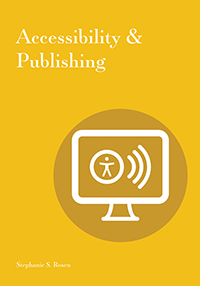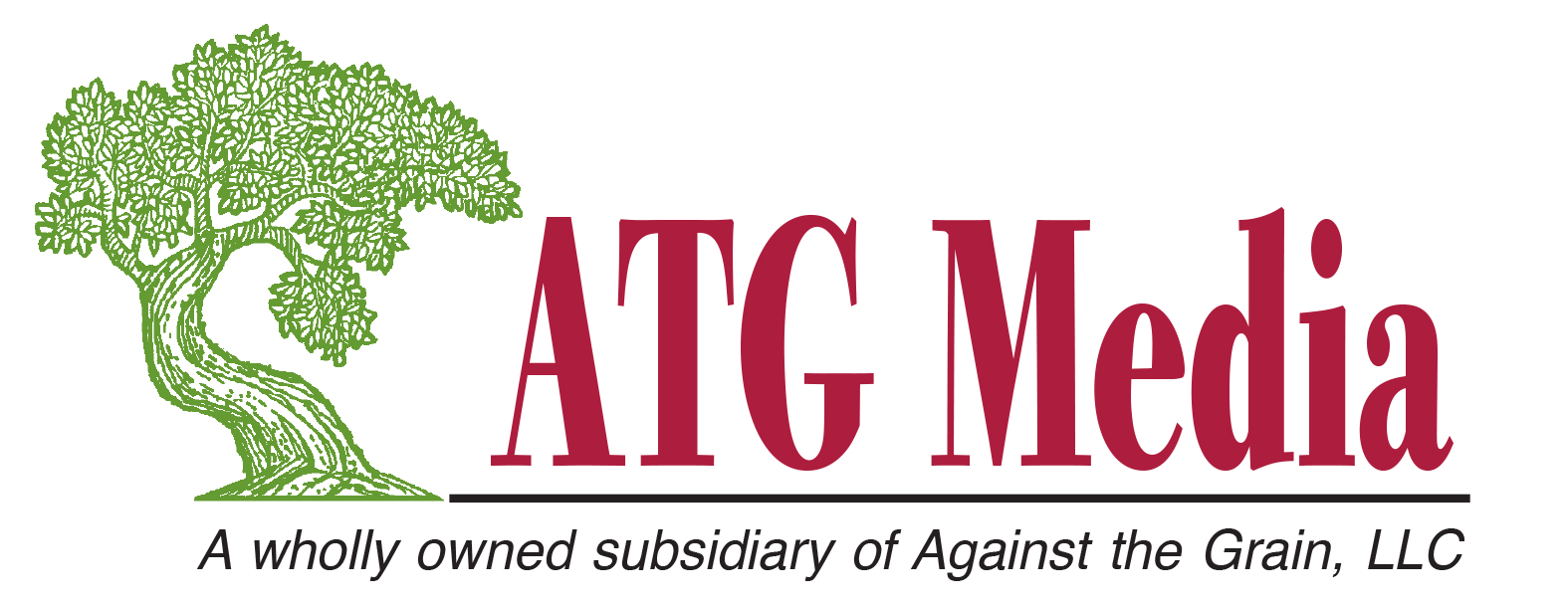
Accessibility & Publishing
Skip other details (including permanent urls, DOI, citation information): This work is licensed under a Creative Commons Attribution-NonCommercial-NoDerivatives 4.0 International License. Please contact [email protected] to use this work in a way not covered by the license.
For more information, read Michigan Publishing's access and usage policy.
Chapter 7. Born Accessible
As long as there has been born-digital content, there has been the potential for born-accessible content. Indeed, some early online publications took immediate advantage of this potential and have been creating accessible content for almost two decades. Now, as a greater share of published content becomes digital, and even print publications come from digital, there is greater potential for born-accessible publications.
Accessibility in Digital Scholarship on the Web
The language of the Web, HTML, has had accessibility standards published by the World Wide Web Consortium (W3C) since 1999.[1] Some digital scholarship published on the Web has taken these standards into account, thereby leading the way in accessible scholarly publishing.
One of the first examples of this can be found in Currents: An E-Journal, the scholarly publication of the Digital Writing and Research Lab (formerly the Computer Writing and Research Lab) at the University of Texas at Austin. This online scholarly journal included editorial guidelines regarding accessible markup in their Submission Guidelines as early as their first issue in 1999[2] and official policy that “all published contributions must meet the W3C accessibility standards” as early as 2002 (“Editorial Information,” 2002). Currents was edited by an early leader in the field of Web accessibility, John Slatin, who was also at the intersections of scholarship and pedagogy. Slatin was an early member of the W3C, a leader in Web accessibility, and the author of a 2001 Computers and Composition journal article, “The Art of Alt,” which alerted others in the field to the importance of “alt text” for images and other accessibility features in Web design.
Another early example of born-accessible scholarly publishing can be found in Kairos: A Journal of Rhetoric, Technology, and Pedagogy. The longest continuously published online peer-reviewed journal in its field, Kairos began publication in 1996 and has required accessible submission from its authors since around 2001 (C. Ball, personal communication, March 9, 2018). Later examples include the Canadian Journal of Disability Studies, published online, open access, and in accordance with accessibility standards since 2012, and Disability Studies Quarterly, online and in accordance with accessibility standards as of 2007.
In each case, the journal has made a commitment to accessibility and achieved it by focusing efforts in two areas. First, by making its own online interface accessible according to WCAG standards and, second, by using submission guidelines and the editorial process to ensure that each submission has met the standards as well. Now that the standards and practices developed for Web accessibility have been repurposed for the electronic book format EPUB, more publishers have the opportunity to take on this role, promoting accessibility through the editorial process for more types of publications, including the key academic genre of the scholarly monograph.
Born-Accessible Electronic Books
The EPUB electronic publishing standard, from Version 3 forward, combines standards developed for the Web with standards for accessible format books. As Bill Kasdorf (2013) wrote,
The Working Group released EPUB 3.0 at the Frankfurt Book Fair in October 2011 … The new standard is based on HTML5, the lingua franca of the modern Web, along with its companion Web standards CSS3 (cascading style sheets, for presentation) and JavaScript (for scripting behaviour-based features like user interaction). Not only does this enable EPUB 3 to accommodate audio, video, interactivity and other important features, it does so in the same way those things are accomplished using modern browsers and other Web technologies. Likewise, it accommodates non-Latin alphabets and both right-to-left and vertical writing; and thanks to the invaluable participation of key staff of the DAISY Consortium on the EPUB 3 Working Group, it was built to be accessible.
EPUB 3 was built to be accessible at multiple levels, with “accessible content at the core, wrapped in semantic structure, and topped off with accessible metadata” (Rothberg, 2018, p. 45). Not only can EPUBs implement accessibility features, but those features “can be exposed in metadata using Schema.org vocabularies inside the EPUB or on a Web page, or using ONIX metadata in the publisher workflow” to provide users, libraries, distributors, and sellers the information to identify which publications are accessible and in what ways (Rothberg, 2018, p. 45). EPUB accessibility metadata enables transparency and discovery for accessible publications, which is crucial to readers who rely on accessibility features and is a great benefit to users and entities who use accessibility features in various ways, such as a reader who prefers to listen to material read aloud or an entity that searches and indexes.
EPUB’s potential for accessibility, inside and out, has made it the “ ‘gold standard’ in the publishing industry for the production of accessible digital books” (Accessible Books Consortium [ABC], n.d.). Several organizations are working to encourage publishers to adopt the EPUB standard and commit to producing accessible EPUB content. The Society for Disability Studies released an open letter on “Publishing Accessible Books” (n.d.), encouraging publishers to adopt EPUB 3.0 or later for “built-in accessibility (the best solution).” The ABC encourages all publishers to “use the accessibility features of the EPUB3 standard for the production of digital publications” and “include descriptions of the accessibility features of their products in the information they provide to retailers and others in the book supply chain.”
For publishers committed to accessibility, adopting EPUB as an output format will be an important step toward achieving accessibility. However, for publishing organizations with a traditional “print-first” workflow, ensuring the output of accessible EPUB will come with challenges. Although print-first publishing workflows are themselves digital, a digital file in the final preprint stages may have lost structural information from earlier stages and may lack accessibility information—both of which are necessary to output an accessible EPUB.
Challenges for Publishers
In a traditional print-first publishing workflow, a book typically follows a pathway “from a manuscript to a designed PDF ready to be printed” (de Bruijn et al., 2015, p. 26). Along that pathway, the content may pass through several proprietary formats, lose some embedded information, and ultimately get optimized for print layout rather than digital delivery. This workflow presents some challenges for digital output, and creating an accessible EPUB from a print-optimized PDF may more closely resemble print conversion than born-accessible publishing, with all the additional labor that comes with it. Changing a traditional workflow to support born-accessible EPUB will be a labor-intensive process of assessment and systemic change. However, it will ensure that future accessibility work is done at the right point in the workflow, by the right people, to optimize output and eliminate unnecessary processes.
As Bill Kasdorf (2018) has explained,
if the production workflow is properly designed and executed, much of this [remediation] work goes away. Especially if there is an XML-based workflow, and even better if that workflow is designed to produce EPUB 3 as one of its deliverables, then a lot of straightforward text-based books (novels and straightforward non-fiction, even scholarly monographs) are close to being sufficiently accessible at almost no extra cost… . Even for books with images, if the workflow provides a mechanism for authors to supply alt text and extended descriptions (and if they are properly instructed how to do that), work is reduced even further.
As this quote suggests, books with images or visual content present additional challenges. Since accessibility standards require that all “nontext content,” (images, multimedia, audio, etc.) must have a “textual equivalent,” images require textual descriptions that sufficiently communicate their meaning and purpose to a reader who cannot access the original. And because images are fairly common in academic monographs, publishing books with sufficient description of those images may represent a major change in workflow. Although disability service offices that perform text conversion often create description of visual content, born-accessible publications should ensure that description is created as far as possible upstream in the publishing workflow so it becomes an integrated part of the publication. The Describing Visual Resources Toolkit (Rosen, 2017a) has noted, “In academic publications in the arts and humanities, description must be scholarly as well as accessible, and in line with existing standards: metadata, copyright, and disciplinary conventions. It is therefore best managed by the scholars, academic publishers, and arts organizations who create the publications.” Ideally, not only publishers but also authors should include image description in their practice, and indeed this is common practice among many scholars writing in disability studies.
Other content features may introduce additional challenges, especially for publications marketed for postsecondary education. In addition to the text itself (including images, tables, and formulae) content categories to consider for accessibility include enhancements, linked content, and contributed content (Bowes, 2018). Enhancements are enrichments including multimedia elements, interactives, labs, assessments, and quizzes; linked content is Internet-based content that becomes part of the user’s experience when linked to from the product; and contributed content is user-generated content that is uploaded or shared within the learning experience (e.g., collaborative class projects, online assignments) (Bowes, 2018). All of these content categories introduce additional accessibility considerations. Yet all of them have the potential to be made accessible with intentional workflows and the use of EPUB and accessibility standards.
In all cases and across content types, the ability to achieve accessibility in the product is closely related to education and support for the content creators. This is true whether the content creators are students uploading an assignment to a shared learning management system, authors submitting manuscripts to a publisher, or publishers contributing books and journals to publishing platforms.
1. WCAG 1.0 was ratified by the W3C in 1999, building largely on the Unified Web Site Accessibility Guidelines (Vanderheiden & Chisholm, 1998), developed by the Trace Research & Development Center at University of Wisconsin, Madison, from 1995 to 1998.
2. The Submission Guidelines (1999) state, “We ask, however, that such submissions take into account reader-access issues, and that they routinely incorporate such accommodations as the inclusion of <alt> tags in any image and the use of content tags (e.g., citation <cite> and emphasis <em> tags) instead of the corresponding physical markup tags (e.g., italics <i> and bold <b> tags) whenever possible.”

